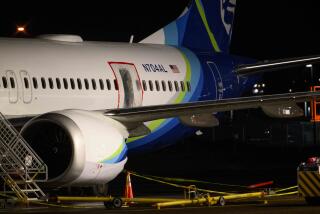Thinner seats in back leave more room for high-paying fliers up front

If you fly in the economy section, it may seem lately that you’re sharing the cabin with more passengers than ever.
In fact, a new analysis suggests that some airlines are carrying slightly fewer passengers per plane, but it may seem crowded because more room has been set aside for passengers in the front of the cabin and less to fliers in the back.
The shift in cabin space is evident by the number of airlines that have installed “slim line” seats for economy and coach passengers while adding extra rows of roomy seats for high-paying business- and first-class passengers, said John Walton, data director for the flight rating site Routehappy.com.
Slim-line seats have thin cushions in the backrest, allowing airlines to squeeze in an extra row of seats.
For his analysis, Walton compared the original seat arrangement for several carriers with the seating layout today.
For example, United Airlines launched the Boeing 777-200 in 1995 with 12 first-class passenger seats, 49 business-class seats and 231 in economy — for a total of 292 seats. Today, one popular layout for the same plane has eight first-class seats, 40 business-class seats and 221 seats in economy — for a total of 269 seats, he said.
To make room for new, roomier, lie-flat seats in the first- and business-class sections, Walton said, United squeezed more coach seats into areas of the cabin that were previously occupied by galleys and lavatories.
In fact, the United 777-200s typically have four or five lavatories for the economy section, compared with six in the original configuration.
“Every inch you can save means another row of seats in the back,” Walton said.
Seth Kaplan, founding partner for the trade publication Airline Weekly, said he can’t confirm Walton’s analysis but agrees that passengers in the back of the plane are getting squeezed more today to make room for travelers in the front.
“Densification is a major trend in the industry now,” he said.
Waiting leaves fliers dissatisfied
Tom Petty had it right: The waiting is the hardest part.
Among the key findings in this year’s J.D. Power airline satisfaction report were numbers showing that satisfaction levels among travelers drop sharply when they are required to wait for boarding passes and luggage.
The annual study that surveyed 11,370 travelers who flew in the previous 12 months found that satisfaction with an airline was 41 points lower if the flier had to wait 15 minutes or longer to get a boarding pass, compared with those who waited less than 15 minutes. The study measured satisfaction on a 1,000-point scale.
The same survey found that satisfaction levels also dropped 41 points for passengers who had to wait more than 15 minutes to get their checked bag.
And if an airline loses or misplaces a checked bag, satisfaction levels drop even further, 51 points, compared with travelers who get all of their bags upon arrival, the study found.
“A 40-point index shift is huge,” said Rick Garlick, global travel and hospitality practice lead at J.D. Power. “That represents dissatisfaction among people.”
Hotels offer extreme amenities
In one- or two-star hotels, you might be content to get free waffles or a complimentary newspaper in the morning.
But some luxury hotels go beyond typical perks, according to the travel review site Oyster.com, which recently released a list of the nine most extreme amenities offered at hotels worldwide.
For example, the Ritz Carlton in South Beach Miami employs a “tanning butler,” who patrols the pool, applying sunscreen to guests. At the Lanesborough Hotel in London, a tea sommelier is available to help guests during afternoon tea service.
The Hotel deLuxe in Portland, Ore., offers access to a pet psychic and a pet psychologist for animal guests that are having trouble coping with the pressure in their lives.







